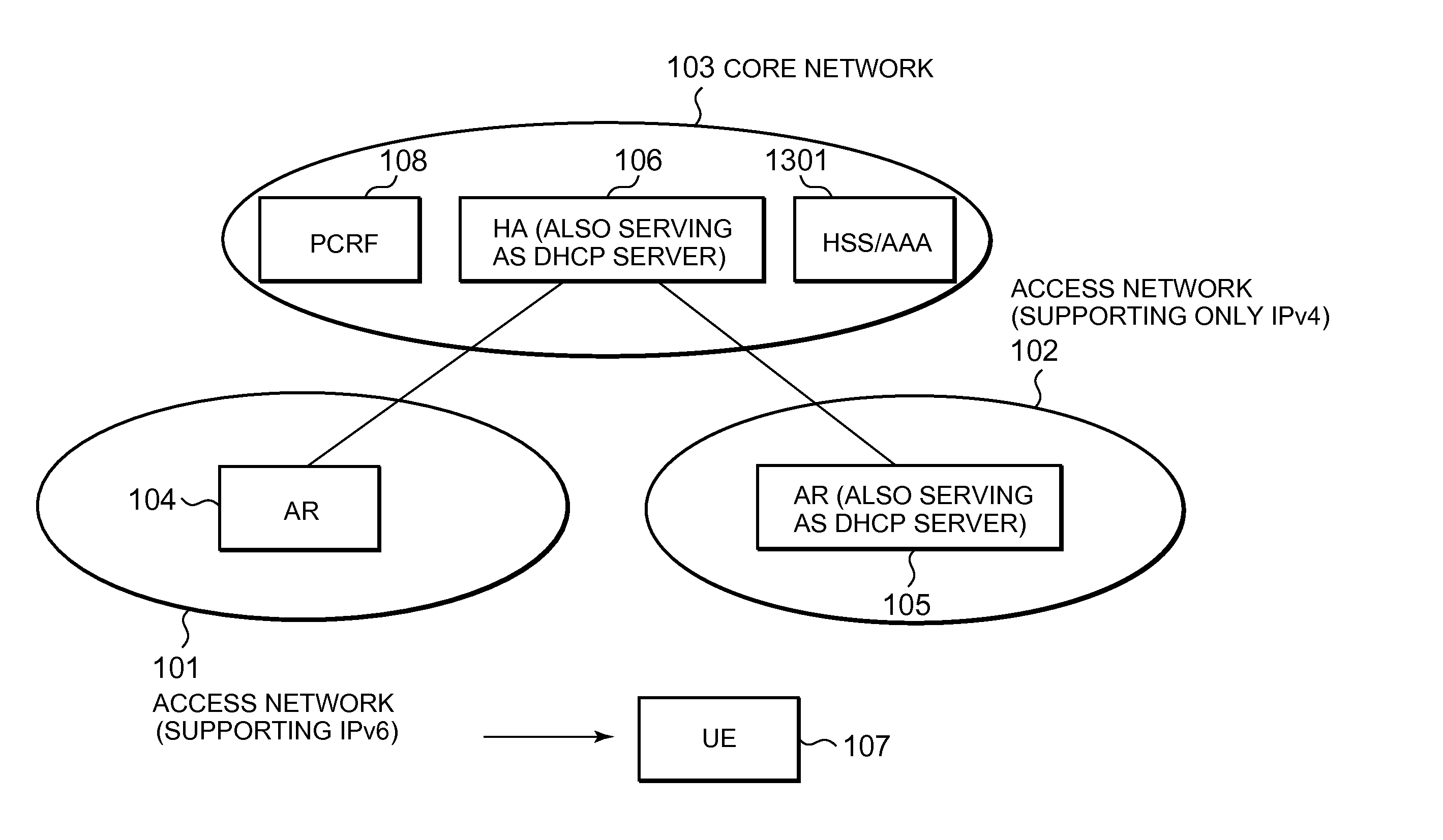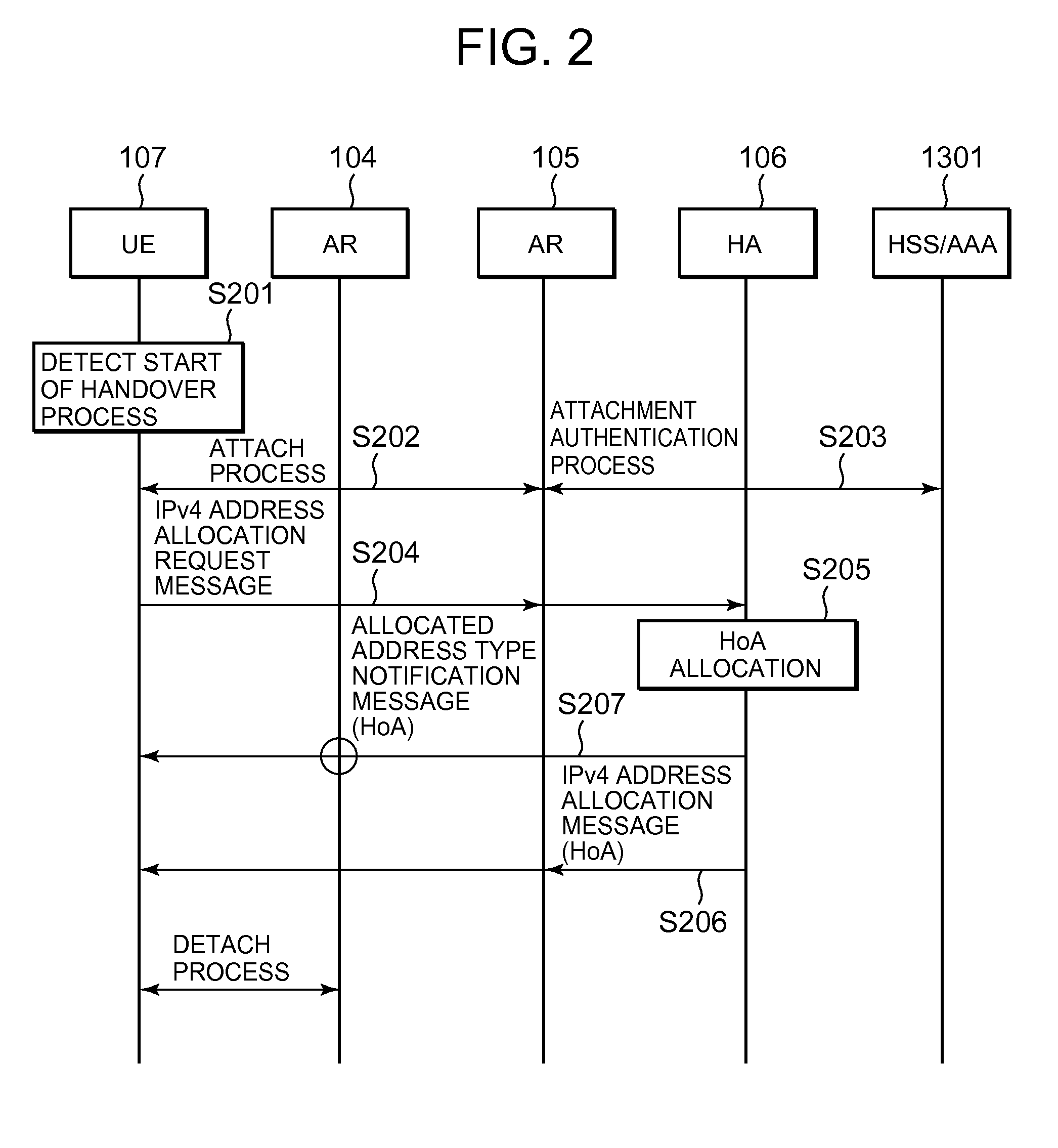[0025]In light of the above-described issues, in a mobile communication
system using DSMIP, when a mobile node having only an IPv6 home address performs a handover to an
access network supporting only IPv4, notification of the type of
IP address (home address or care-of address) allocated to the mobile node in the handover destination network is provided from the home agent to the mobile node via the handover source network, and the mobile node performs home link detection in adherence to a notification acquisition timing. As a result, an object of the present invention is to provide a handover method, and a mobile node and a home agent used in the handover method, in which communication efficiency can be improved by early detecting that the handover destination
access network is the home link and reducing tunnel overhead between the mobile node and the home agent. In addition, even in an instance in which the mobile node performs a key update process, home link detection can be completed before the key update process, and packets can be transmitted and received without waiting for the time-consuming key update process to be completed.
[0026]To achieve the above-described object, the present invention provides a handover method for a mobile node that moves between at least two networks each supporting a different, unique IP version that is a communication protocol of the mobile node in which, when the mobile node performs a handover from an access router before the handover to which the mobile node is currently connected, to an access router of another network of a handover destination, the handover method includes the steps of: transmitting, by the mobile node, an address allocation request message for acquiring an address in the handover destination network allocated to the mobile node, to the
access network of the handover destination; and transmitting, by a home agent of the mobile node, a notification message including information indicating a type of the address of the mobile node allocated by an address allocation
server of the handover destination or the home agent as a result of the address allocation request message, to the mobile node via the access router before the handover. As a result of the configuration, communication efficiency can be improved by detecting that the handover destination access network is a home link at an early stage and reducing tunnel overhead between the mobile node and the home agent. In addition, even when the mobile node performs a key update process, home link detection can be performed before the key update process, and packets can be transmitted and received without waiting for completion of the time-consuming key update process.
Handover time can be reduced.
[0027]In addition, the present invention provides a mobile node that performs a handover between at least two networks each supporting a different, unique IP version that is a communication protocol of the mobile node in which, when the mobile node performs a handover from an access router before the handover to which the mobile node is currently connected to an access router of another network of a handover destination, the mobile node includes: a message generating means for generating an address allocation request message for acquiring an address in the network of the handover destination allocated to the mobile node; a transmitting means for transmitting the generated address allocation request message to the access router of the handover destination; and a receiving means for receiving, from a home agent of the mobile node via the access router before the handover, a notification message including information indicating a type of the address of the mobile node allocated by the address allocation server of the handover destination or the home agent as a result of the address allocation request message. As a result of the configuration, communication efficiency can be improved by detecting that the handover destination access network is a home link at an early stage and reducing tunnel overhead between the mobile node and the home agent. In addition, even when the mobile node performs a key update process, home link detection can be performed before the key update process, and packets can be transmitted and received without waiting for completion of the time-consuming key update process.
Handover time can be reduced.
[0028]In addition, the present invention provides a home agent of a mobile node that performs a handover between at least two networks each supporting a different, unique IP version that is a communication protocol of the mobile node in which, when the mobile node performs a handover from an access router before the handover to which the mobile node is currently connected, to an access router of another network of a handover destination, the home agent includes: a message generating means for generating a notification message inducing information indicating a type of an address of the mobile node allocated by an address allocating sever of the handover destination or the home agent, based on an address allocation request message for acquiring an address in the network of the handover destination allocated to the mobile node; and a transmitting means for transmitting the generated notification message to the mobile node via the access router before the handover. As a result of the configuration, communication efficiency can be improved by detecting that the handover destination access network is a home link at an early stage and reducing tunnel overhead between the mobile node and the home agent. In addition, even when the mobile node performs a key update process, home link detection can be performed before the key update process, and packets can be transmitted and received without waiting for completion of the time-consuming key update process.
Handover time can be reduced.
[0029]The handover method, and the mobile node and the home agent used in the method improve communication efficiency by early detecting that the handover destination access network is a home link and by reducing tunnel overhead between the mobile node and the home agent. In addition, even when the mobile node performs a key update process, home link detection can be performed before the key update process, and packets can be transmitted and received without waiting for completion of the time-consuming key update process. As a result, the handover time can be reduced. In addition, through use of DSMIP connection already established via the handover source access network, even when the handover destination access network does not have a function for directly notifying the mobile node, desired operations can be performed.
 Login to View More
Login to View More  Login to View More
Login to View More 


